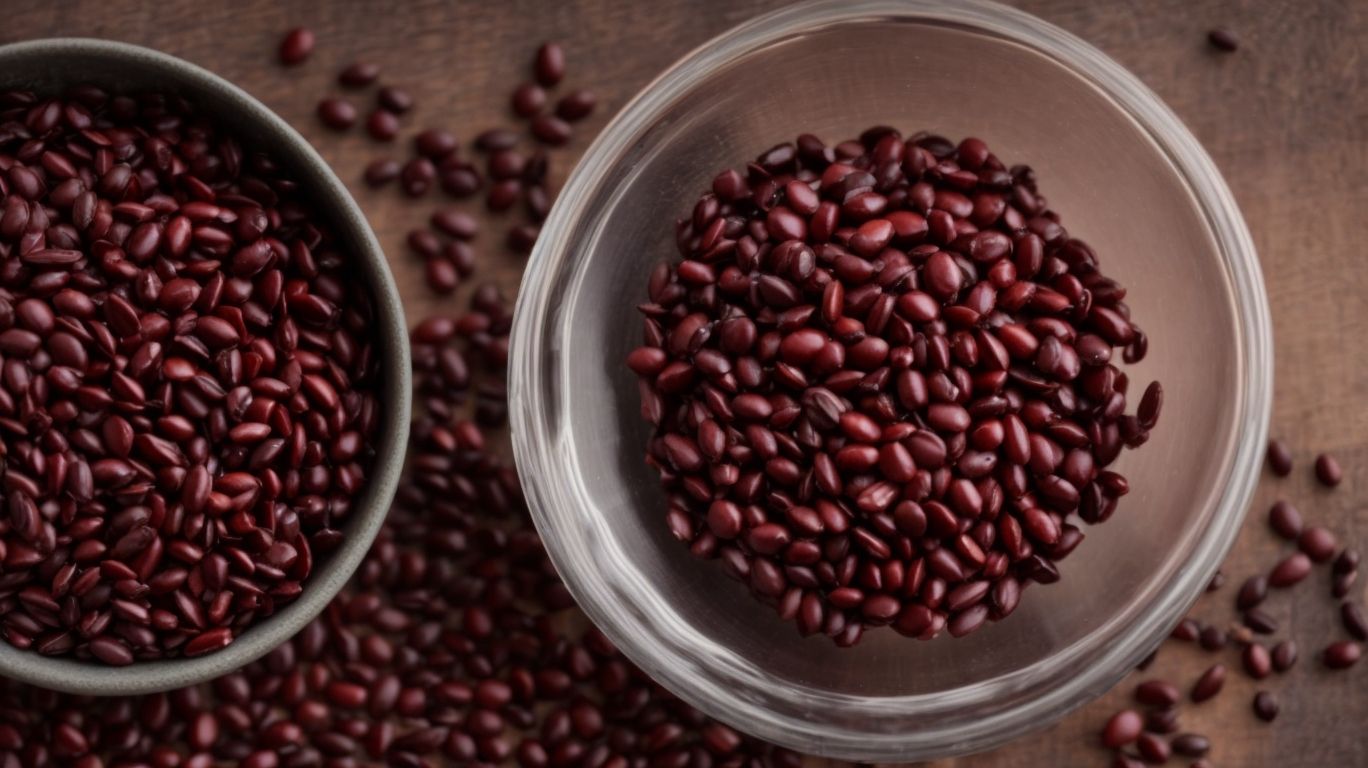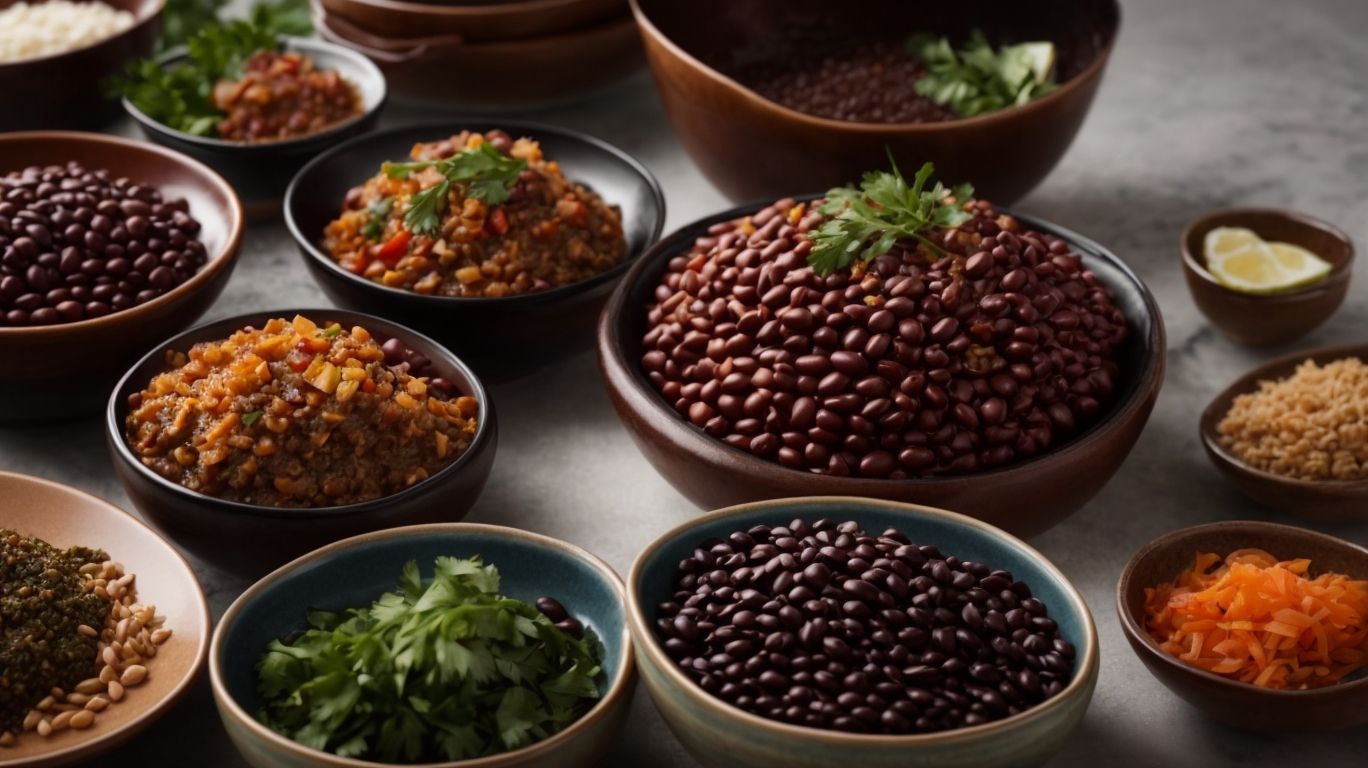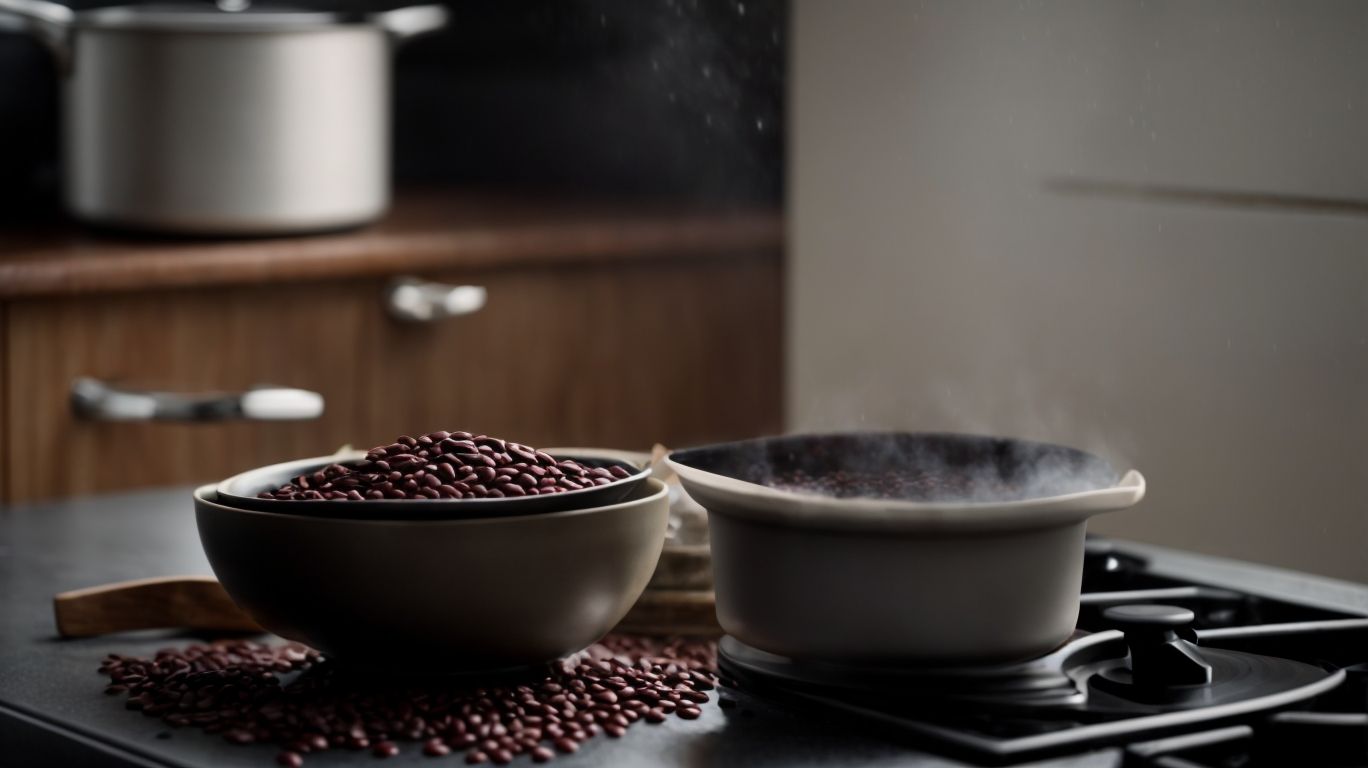How to Cook Adzuki Beans After Soaking?
Curious about adzuki beans and how to incorporate them into your cooking routine? Look no further!
We will explore what adzuki beans are, their nutritional benefits, and how to prepare and cook them. From soaking to seasoning, we’ll cover all the steps you need to know to make the most delicious adzuki bean dishes.
Whether you’re craving a hearty soup, a refreshing salad, or even some decadent brownies, adzuki beans have got you covered. So, let’s get cooking!
Key Takeaways:
What Are Adzuki Beans?
Adzuki beans, also known as red mung beans, are small, red beans commonly grown in East Asia and are popular in various cuisines.
These beans have been cultivated in East Asia for thousands of years and are believed to have originated in ancient China. Adzuki beans are characterized by their distinct reddish-brown color and small size, about half the size of a regular kidney bean. Their versatility in both sweet and savory dishes makes them a sought-after ingredient in Asian cooking. From traditional Japanese sweets like dorayaki to Korean porridge and Chinese soups, adzuki beans add a unique flavor and texture.
What Are the Nutritional Benefits of Adzuki Beans?
Adzuki beans offer a range of nutritional benefits, including being rich in antioxidants, promoting heart health, providing protein and fiber, and containing essential minerals like iron, folate, and magnesium.
These beans are particularly beneficial for heart health due to their high levels of potassium, a mineral that helps regulate blood pressure and reduce the risk of cardiovascular diseases. Adzuki beans are an excellent source of plant-based protein, making them a valuable addition to vegetarian and vegan diets.
With their impressive fiber content, adzuki beans support digestive health by aiding in proper digestion and promoting bowel regularity. Their mineral composition contributes to overall well-being, with iron being crucial for oxygen transport in the body, folate playing a key role in cell division, and magnesium supporting various biochemical processes.
How to Prepare Adzuki Beans for Cooking?
To prepare adzuki beans for cooking, it’s essential to start with soaking the beans to aid in their cooking process and enhance digestibility, followed by draining and rinsing to remove any impurities or debris.
Soaking Adzuki Beans
Soaking adzuki beans before cooking is crucial to reduce cooking time, enhance texture, and improve overall digestibility by breaking down complex sugars.
Regarding soaking adzuki beans, the ideal duration is around 8 to 12 hours in cold water.
During this soaking process, changing the water at least once can further aid in removing enzyme inhibitors and phytic acid, promoting better nutrient absorption.
Soaking not only softens the beans, making them quicker to cook, but also enhances their creamy consistency when added to dishes like stews, soups, or salads.
The breakdown of complex sugars and proteins due to soaking can also make adzuki beans easier on the digestive system, reducing potential bloating or gas after consumption.
Draining and Rinsing Adzuki Beans
Draining and rinsing adzuki beans post-soaking is essential to remove any residual toxins, antinutrients, or impurities that may affect taste and digestibility.
This process not only helps in making the beans more flavorful but also promotes better digestion and nutrient absorption.
After soaking the beans for the required time, drain out the soaking water completely using a fine mesh strainer. Then, rinse the beans thoroughly under cold running water to wash away any remaining impurities. This simple step significantly reduces the chances of digestive discomfort and ensures that you get the full nutritional benefits without any unwanted compounds.
How to Cook Adzuki Beans?

Credits: Poormet.Com – Willie Martinez
Cooking adzuki beans can be done using various methods, such as stovetop simmering for a traditional approach or using a pressure cooker for a faster cooking time and enhanced convenience.
Using a Stovetop
Cooking adzuki beans on a stovetop involves simmering the beans in water or broth until tender, allowing for a traditional and hands-on cooking experience that enhances flavor and texture.
For the ideal water ratio, aim for covering the beans with about 2 inches of liquid in the pot. This helps in proper hydration and ensures even cooking. When simmering, select a gentle heat setting to prevent the beans from breaking apart. Typically, adzuki beans require around 40-50 minutes to cook through, but this can vary based on freshness and desired tenderness. Adding bay leaves, garlic, or a sprinkle of salt can enhance the flavor profile, creating a savory base for various dishes.
Using a Pressure Cooker
Utilizing a pressure cooker to cook adzuki beans results in faster cooking times and softer textures, making it a convenient option for busy individuals seeking efficient meal preparation.
Cooking adzuki beans in a pressure cooker not only saves time but also ensures that the beans retain more of their natural flavors compared to other cooking methods. The high pressure in the cooker helps to break down the beans faster, resulting in a creamy and velvety texture that is perfect for soups, stews, or even salads.
Additionally, pressure cooking helps to preserve the nutritional value of the beans, ensuring that you get all the health benefits without compromising on taste. By following simple steps and adjusting the cooking time according to your preference, you can enjoy delicious adzuki beans in no time.
How to Season Adzuki Beans?
Seasoning adzuki beans is a creative process that involves adding salt and pepper for simplicity, incorporating herbs and spices for depth of flavor, and experimenting with other flavorings to customize taste preferences.
Salt and Pepper
Seasoning adzuki beans with salt and pepper provides a simple yet effective way to enhance the beans’ natural flavors and balance their taste profile.
The addition of salt helps to amplify the inherent flavors of the adzuki beans, while pepper adds a subtle kick of spice, elevating the dish to a new level. When seasoning adzuki beans, it’s crucial to use salt and pepper judiciously, tasting as you go to achieve the desired level of seasoning. You can experiment with different types of salt, such as sea salt or Himalayan salt, to impart unique undertones to the beans. For pepper, freshly ground black pepper is often recommended to maximize flavor.
Herbs and Spices
Enhancing adzuki beans with a variety of herbs and spices like cumin, paprika, or parsley can elevate the flavor profile and introduce aromatic complexity to the dish.
When adding cumin to adzuki beans, the warm earthy tones complement the beans’ natural nuttiness, creating a harmonious blend of flavors. Paprika adds a subtle smokiness, while parsley provides a fresh, herbaceous note that brightens up the dish.
These herbs and spices not only enhance the taste of adzuki beans but also offer various health benefits. Cumin is known for its digestive properties, paprika adds a punch of Vitamin C, and parsley is rich in antioxidants.
For a flavorful recipe idea, consider making a spicy adzuki bean stew with cumin, paprika, and parsley, served over fluffy rice. This dish is a comforting and nutritious option that will surely satisfy your taste buds.
Other Flavorings
Experimenting with unique flavorings such as soy sauce, miso paste, or citrus zest can offer a creative twist to adzuki beans, allowing for diverse and customized taste experiences.
While soy sauce brings a savory umami depth to the beans, miso paste introduces a rich complexity that enhances their earthy notes. On the other hand, the addition of citrus zest provides a refreshing and tangy contrast, brightening up the dish.
Combining these ingredients not only elevates the flavors of the adzuki beans but also opens up a world of culinary experimentation. From stir-fries to salads, soups, or even desserts, these unconventional pairings can transform a simple bean dish into a gourmet delight.
What Dishes Can You Make with Cooked Adzuki Beans?

Credits: Poormet.Com – Kyle Anderson
Cooked adzuki beans can be transformed into a variety of delicious dishes, including adzuki bean soup, salad, curry, and even sweet treats like adzuki bean brownies.
Adzuki Bean Soup
Adzuki bean soup is a hearty and nutritious dish that combines the earthy flavors of adzuki beans with aromatic herbs and savory broth for a comforting meal option.
Making adzuki bean soup is not only delicious but also provides a plethora of health benefits. With the richness of fiber and protein from the adzuki beans, this soup is a great choice for those looking to incorporate more plant-based proteins into their diet.
To prepare this wholesome dish, start by rinsing and soaking the adzuki beans overnight to ensure they cook evenly and have a creamy texture. Once soaked, simmer the beans with onions, garlic, and a bay leaf in vegetable broth until they are tender.
For an added depth of flavor, consider incorporating smoked paprika and a dash of coconut milk towards the end of cooking. These flavor enhancers will elevate the taste profile of the soup and provide a hint of creaminess.
Adzuki Bean Salad
Adzuki bean salad is a refreshing and protein-packed dish featuring a medley of colorful vegetables, tangy dressings, and flavorful seasonings that complement the nutty taste of adzuki beans.
One popular variation of adzuki bean salad includes ingredients like diced cucumbers, cherry tomatoes, bell peppers, and red onions, all mixed with the earthy adzuki beans.
To enhance the flavor profile, a dressing made with olive oil, lemon juice, garlic, and a touch of honey can be drizzled over the salad.
This salad not only provides a delightful burst of flavors but also offers a wealth of nutrients, boasting high levels of protein, fiber, and essential vitamins.
For a creative twist, consider adding fresh herbs like cilantro or mint, or incorporating elements like feta cheese or toasted nuts for added texture.
Adzuki Bean Curry
Adzuki bean curry is a fragrant and wholesome dish infused with aromatic spices, creamy coconut milk, and tender adzuki beans, offering a satisfying and flavorful meal option.
This traditional dish hails from Asian cuisine, particularly popular in Japanese, Korean, and Indian cooking. With its rich and complex flavors, adzuki bean curry is a versatile recipe that can be customized to suit different palates. To make this delectable dish, you can combine turmeric, cumin, coriander, and garam masala in a pan to create a fragrant base. Slow-cooking the beans with these spices allows the flavors to meld together, resulting in a comforting and hearty curry. Garnish with fresh cilantro and serve with steamed rice for a complete meal.
Adzuki Bean Brownies
Adzuki bean brownies are a decadent and guilt-free dessert option that combines the richness of chocolate with the nutty sweetness of adzuki beans for a fudgy and satisfying treat.
For those looking to sneak in some extra nutrients into their sweet treats, adzuki bean brownies are the perfect choice. The natural creaminess of the adzuki beans creates a moist texture in the brownies, giving them a velvety finish.
When baking these brownies, it’s essential to blend the adzuki beans until smooth to ensure a uniform texture. Pairing the beans with premium quality dark chocolate intensifies the chocolate flavor and adds a touch of bitterness that balances the natural sweetness of the beans.
The health benefits of adzuki beans, such as being rich in fiber and protein, make these brownies more than just a dessert – they can be a nutritious snack option. The culinary creativity behind incorporating beans into traditional desserts like brownies showcases the versatility of adzuki beans in various recipes.
Tips for Cooking with Adzuki Beans
When cooking with adzuki beans, consider incorporating other fiber-rich ingredients for enhanced nutritional value, experimenting with various cooking methods to explore flavor profiles, and adjusting seasoning to suit personal preferences.
Frequently Asked Questions
How to Cook Adzuki Beans After Soaking?
1. What are adzuki beans and why should I soak them before cooking?
Adzuki beans are small, red beans commonly used in Asian cuisine. Soaking them before cooking helps to soften the beans, shorten their cooking time, and make them easier to digest.
2. How long should I soak adzuki beans for?
You should soak adzuki beans for at least 6-8 hours, or overnight. This will allow the beans to fully absorb water and soften.
3. Can I use the soaking water when cooking adzuki beans?
Yes, you can use the soaking water when cooking adzuki beans. It contains some of the nutrients that the beans have absorbed during soaking.
4. What is the best method for cooking adzuki beans after soaking?
The best method for cooking adzuki beans after soaking is to drain them and rinse them with fresh water. Then, add them to a pot with enough water to cover them by about 2 inches. Bring to a boil, then reduce heat and let simmer for about 45 minutes to 1 hour, or until tender.
5. Can I cook adzuki beans in a pressure cooker after soaking?
Yes, you can cook adzuki beans in a pressure cooker after soaking. Follow the same steps for draining and rinsing the beans, then add them to the pressure cooker with enough water to cover them by about 2 inches. Cook on high pressure for about 8-10 minutes.
6. What are some ways to use cooked adzuki beans?
Cooked adzuki beans can be used in a variety of dishes, such as soups, stews, salads, and even desserts. They can also be mashed and made into burgers or added to dips and spreads. Get creative and experiment with different recipes!







